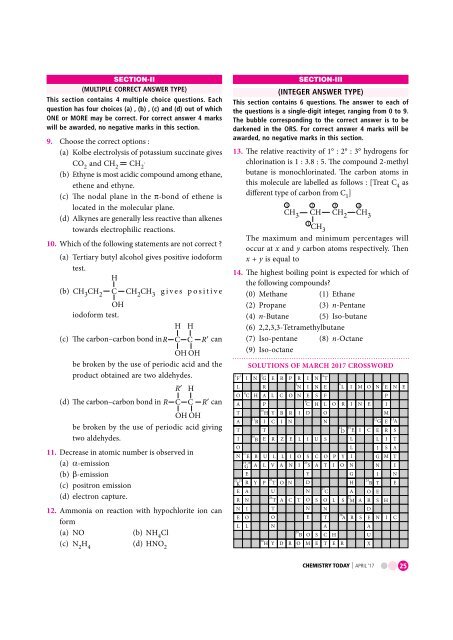Chemistry_Today_April_2017_vk_com_stopthepress
You also want an ePaper? Increase the reach of your titles
YUMPU automatically turns print PDFs into web optimized ePapers that Google loves.
SECTION-II<br />
(MULTIPLE CORRECT ANSWER TYPE)<br />
This section contains 4 multiple choice questions. Each<br />
question has four choices (a) , (b) , (c) and (d) out of which<br />
ONE or MORE may be correct. For correct answer 4 marks<br />
will be awarded, no negative marks in this section.<br />
9. Choose the correct options :<br />
(a) Kolbe electrolysis of potassium succinate gives<br />
CO 2<br />
and CH 2<br />
CH<br />
.<br />
2<br />
(b) Ethyne is most acidic <strong>com</strong>pound among ethane,<br />
ethene and ethyne.<br />
(c) The nodal plane in the π-bond of ethene is<br />
located in the molecular plane.<br />
(d) Alkynes are generally less reactive than alkenes<br />
towards electrophilic reactions.<br />
10. Which of the following statements are not correct ?<br />
(a) Tertiary butyl alcohol gives positive iodoform<br />
test.<br />
H<br />
(b) CH 3 CH 2 C CH 2 CH 3 gives positive<br />
OH<br />
iodoform test.<br />
H H<br />
(c) The carbon–carbon bond inR C C R<br />
can<br />
OH OH<br />
be broken by the use of periodic acid and the<br />
product obtained are two aldehydes.<br />
2 1<br />
3<br />
F I N G E<br />
R H<br />
L R<br />
(d) The carbon–carbon bond in R C C R<br />
can<br />
10<br />
T H Y<br />
OH OH<br />
A R I C<br />
be broken by the use of periodic acid giving<br />
T T<br />
16<br />
two aldehydes.<br />
I B E R<br />
O<br />
11. Decrease in atomic number is observed in<br />
17<br />
N E B U L<br />
19 18<br />
(a) α-emission<br />
G A L V<br />
(b) β-emission<br />
E<br />
22 21<br />
23<br />
(c) positron emission<br />
K R Y P T<br />
E A U<br />
(d) electron capture.<br />
26<br />
R N T<br />
N I T<br />
12. Ammonia on reaction with hypochlorite ion can<br />
E O O<br />
form<br />
L L N<br />
(a) NO<br />
(b) NH 4<br />
Cl<br />
30<br />
(c) N 2<br />
H 4<br />
(d) HNO H Y 2<br />
O<br />
8<br />
C H A L<br />
A P<br />
R<br />
B<br />
I<br />
Z<br />
L<br />
A<br />
O<br />
A<br />
D<br />
C<br />
1<br />
P<br />
R<br />
N<br />
E<br />
I<br />
N<br />
N<br />
C<br />
R<br />
O<br />
SECTION-III<br />
1<br />
CH 3<br />
4<br />
R I N T<br />
N I N E<br />
I D O<br />
N<br />
D<br />
L I U S<br />
O S C O P Y<br />
20<br />
I S A T I O<br />
Y<br />
D<br />
25<br />
N C<br />
T O S O L S<br />
N N<br />
28<br />
E T<br />
A<br />
29<br />
B O S C H<br />
O M E T E R<br />
N E S F<br />
9<br />
C H L<br />
(INTEGER ANSWER TYPE)<br />
This section contains 6 questions. The answer to each of<br />
the questions is a single-digit integer, ranging from 0 to 9.<br />
The bubble corresponding to the correct answer is to be<br />
darkened in the ORS. For correct answer 4 marks will be<br />
awarded, no negative marks in this section.<br />
13. The relative reactivity of 1° : 2° : 3° hydrogens for<br />
chlorination is 1 : 3.8 : 5. The <strong>com</strong>pound 2-methyl<br />
butane is monochlorinated. The carbon atoms in<br />
this molecule are labelled as follows : [Treat C 4<br />
as<br />
different type of carbon from C 1<br />
]<br />
2 3 4<br />
CH3 CH CH2 CH3<br />
The maximum and minimum percentages will<br />
occur at x and y carbon atoms respectively. Then<br />
x + y is equal to<br />
14. The highest boiling point is expected for which of<br />
the following <strong>com</strong>pounds?<br />
(0) Methane (1) Ethane<br />
(2) Propane (3) n-Pentane<br />
(4) n-Butane (5) Iso-butane<br />
(6) 2,2,3,3-Tetramethylbutane<br />
(7) Iso-pentane (8) n-Octane<br />
(9) Iso-octane<br />
SOLUTIONS OF MARCH <strong>2017</strong> CROSSWORD<br />
5 6 7<br />
L I M O N E<br />
P<br />
N E<br />
O R I N E I<br />
M<br />
14 15<br />
E<br />
L<br />
L<br />
I<br />
I C<br />
G<br />
E<br />
L<br />
I<br />
G<br />
E<br />
R<br />
I<br />
S<br />
M<br />
A<br />
S<br />
T<br />
A<br />
T<br />
N N I<br />
G I N<br />
24<br />
H B T E<br />
A O E<br />
27<br />
M A R S H<br />
D<br />
A R S E N I C<br />
A<br />
U<br />
X<br />
11 12 13<br />
CHEMISTRY TODAY | APRIL ‘17 25


